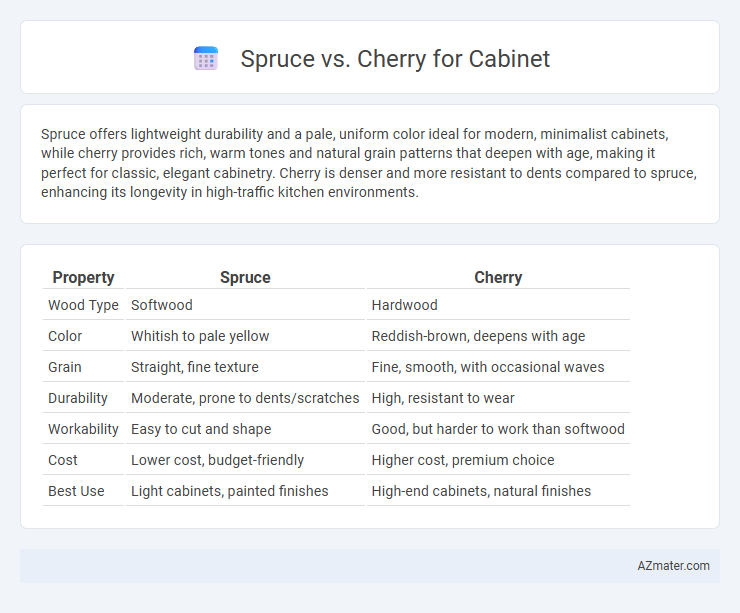Spruce offers lightweight durability and a pale, uniform color ideal for modern, minimalist cabinets, while cherry provides rich, warm tones and natural grain patterns that deepen with age, making it perfect for classic, elegant cabinetry. Cherry is denser and more resistant to dents compared to spruce, enhancing its longevity in high-traffic kitchen environments.
Table of Comparison
| Property | Spruce | Cherry |
|---|---|---|
| Wood Type | Softwood | Hardwood |
| Color | Whitish to pale yellow | Reddish-brown, deepens with age |
| Grain | Straight, fine texture | Fine, smooth, with occasional waves |
| Durability | Moderate, prone to dents/scratches | High, resistant to wear |
| Workability | Easy to cut and shape | Good, but harder to work than softwood |
| Cost | Lower cost, budget-friendly | Higher cost, premium choice |
| Best Use | Light cabinets, painted finishes | High-end cabinets, natural finishes |
Introduction to Spruce and Cherry Wood
Spruce wood, known for its light color and straight grain, offers a softwood option that is lightweight yet strong, making it suitable for cabinet frames and structural components. Cherry wood, a hardwood prized for its rich reddish-brown hue and smooth texture, enhances cabinetry with its durability and elegant aging properties. Both woods provide unique aesthetic and functional benefits, with spruce favored for affordability and ease of work, while cherry is sought after for premium finishes and long-lasting beauty.
Characteristics of Spruce Wood
Spruce wood is lightweight and has a straight, fine grain, making it easy to work with for cabinet construction. Its pale color ranges from creamy white to light yellow, providing a clean, natural look that can be easily stained or painted. Spruce is less dense and softer than cherry, resulting in a more affordable but less durable option for cabinetry.
Characteristics of Cherry Wood
Cherry wood features a fine, straight grain with a rich, reddish-brown color that darkens gracefully over time, offering a warm and elegant appearance for cabinetry. It is known for its smooth texture and moderate hardness, making it durable yet easy to work with for detailed woodworking. Cherry wood's natural resistance to warping and its ability to take stains and finishes well contribute to its popularity in high-end cabinets.
Appearance and Color Differences
Spruce cabinets display a pale, creamy color with subtle yellow undertones, offering a light and airy appearance that brightens kitchen spaces. Cherry wood features rich, reddish-brown hues that darken and deepen with age, providing a warm, elegant look ideal for traditional or classic cabinetry. The color variability in cherry wood adds character, while spruce maintains a more uniform, lighter tone, influencing design choices based on desired ambiance.
Durability and Strength Comparison
Spruce is a softwood with moderate strength and less durability, making it more susceptible to dents and wear in high-traffic areas. Cherry, a hardwood, offers superior durability and strength, with natural resistance to warping and a dense grain structure that withstands daily use effectively. For cabinetry, cherry provides a longer-lasting, more robust option compared to the lighter, less resilient spruce.
Workability and Ease of Finishing
Spruce offers excellent workability due to its softness and lightweight nature, making it easy to cut, shape, and sand for cabinet construction. Cherry, while harder and denser, provides superior ease of finishing with its smooth grain that accepts stains and finishes evenly, enhancing its rich reddish-brown color. Choosing between spruce and cherry often depends on balancing the need for ease of machining with the desired aesthetic finish quality.
Cost and Availability
Spruce cabinets generally cost less than cherry due to the wood's faster growth and broader availability, making it a more budget-friendly option. Cherry wood, known for its rich color and durability, tends to be pricier and less readily available, often sourced from specific regions which can increase lead times. Choosing spruce offers easier access and lower upfront costs, while cherry cabinets provide premium aesthetics at a higher investment.
Best Uses in Cabinetry
Spruce is best suited for lightweight cabinetry and structural components where cost efficiency and ease of finishing are priorities, while cherry wood excels in high-end cabinetry due to its durability, fine grain, and rich color that deepens over time. Cherry cabinets offer exceptional resistance to warping and are ideal for traditional and custom designs that demand elegance and longevity. Spruce's softness makes it less durable for heavy-use cabinets but perfect for painted or veneered surfaces in budget-conscious projects.
Environmental Impact and Sustainability
Spruce cabinets are often lauded for their rapid growth rate and renewable cultivation, making them a more sustainable choice compared to cherry wood, which grows slower and is less abundant. Cherry wood production involves higher environmental costs due to its longer maturity period and the potential for habitat disruption in native hardwood forests. Utilizing FSC-certified spruce enhances eco-friendly building practices and reduces carbon footprint while cherry's durability supports long-term use but may come with greater environmental trade-offs.
Choosing the Right Wood for Your Cabinets
Spruce offers a lightweight and affordable option for cabinet construction, characterized by its pale color and straight grain, making it ideal for painted finishes. Cherry wood provides a durable and hardwood choice with a rich, reddish-brown hue that deepens over time, perfect for elegant and classic cabinetry. Selecting between spruce and cherry depends on desired durability, aesthetic preferences, and budget considerations for long-lasting and visually appealing cabinets.

Infographic: Spruce vs Cherry for Cabinet
 azmater.com
azmater.com